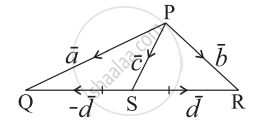Advertisements
Advertisements
Question
Find the unit vector in the direction of the sum of the vectors `vec"a" = 2hat"i" - hat"j" + hat"k"` and `vec"b" = 2hat"j" + hat"k"`.
Solution
Given that `vec"a" = 2hat"i" - hat"j" + hat"k"` and `vec"b" = 2hat"j" + hat"k"`.
`vec"a" + vec"b" = (2hat"i" - hat"j" + hat"k") + (2hat"j" + hat"k")`
= `2hat"i" + hat"j" + 2hat"k"`
∴ Unit vector in the direction of `vec"a" + vec"b" = (vec"a" + vec"b")/|vec"a" + vec"b"|`
= `(2hat"i" + hat"j" + 2hat"k")/sqrt((2)^2 + (1)^2 + (2)^2)`
= `(2hat"i" + hat"j" + 2hat"k")/sqrt(4 + 1 + 4)`
= `(2hat"i" + hat"j" + 2hat"k")/sqrt(9)`
= `(2hat"i" + hat"j" + 2hat"k")/3`
= `2/3hat"i" + 1/3hat"j" + 2/3hat"k"`
Hence, the required unit vector is `2/3hat"i" + 1/3hat"j" + 2/3hat"k"`.
APPEARS IN
RELATED QUESTIONS
if `veca = 2hati - hatj - 2hatk " and " vecb = 7hati + 2hatj - 3hatk`, , then express `vecb` in the form of `vecb = vec(b_1) + vec(b_2)`, where `vec(b_1)` is parallel to `veca` and `vec(b_2)` is perpendicular to `veca`
Write a unit vector making equal acute angles with the coordinates axes.
If \[\overrightarrow{a} = \hat{i} + \hat{j} , \vec{b} = \hat{j} + \hat{k} \text{ and }\vec{c} = \hat{k} + \hat{i} ,\] write unit vectors parallel to \[\overrightarrow{a} + \overrightarrow{b} - 2 \overrightarrow{c} .\]
Write a unit vector in the direction of \[\overrightarrow{a} = 3 \hat{i} + 2 \hat{j} + 6 \hat{k} .\]
Write a unit vector in the direction of \[\overrightarrow{b} = 2 \hat{i} + \hat{j} + 2 \hat{k}\].
Write a unit vector in the direction of \[\overrightarrow{PQ}\], where P and Q are the points (1, 3, 0) and (4, 5, 6) respectively.
If \[\vec{a}\], \[\vec{b}\], \[\vec{c}\] and \[\vec{d}\] are the position vectors of points A, B, C, D such that no three of them are collinear and \[\vec{a} + \vec{c} = \vec{b} + \vec{d} ,\] then ABCD is a
If \[\vec{a}\text{ and }\vec{b}\] are two collinear vectors, then which of the following are incorrect?
In the given figure express `bar"c"` and `bar"d"` in terms of `bar"a"` and `bar"b"`.

Find the coordinates of the point which is located three units behind the YZ-plane, four units to the right of XZ-plane, and five units above the XY-plane.
Let `bara = hati - hatj, barb = hatj - hatk, barc = hatk - hati.` If `bard` is a unit vector such that `bara * bard = 0 = [(barb, barc, bard)]`, then `bard` equals ______.
In a parallelogram ABCD, diagonal vectors are `bar"AC" = 2hat"i" + 3hat"j" + 4hat"k" and bar"BD" = - 6hat"i" + 7hat"j" - 2hat"k"`, then find the adjacent side vectors `bar"AB" and bar"AD"`.
If two sides of a triangle are `hat"i" + 2hat"j" and hat"i" + hat"k"`, find the length of the third side.
Express the vector `bar"a" = 5hat"i" - 2hat"j" + 5hat"k"` as a sum of two vectors such that one is parallel to the vector `bar"b" = 3hat"i" + hat"k"` and other is perpendicular to `bar"b"`.
State whether the expression is meaningful. If not, explain why? If so, state whether it is a vector or a scalar:
`bar"a".(bar"b" + bar"c")`
For any vector `overlinex` the value of `(overlinex xx hati)^2 + (overlinex xx hatj)^2 + (overlinex xx hatk)^2` is equal to ______
If the vectors `xhat"i" - 3hat"j" + 7hat"k" and hat"i" + "y"hat"j" - "z"hat"k"` are collinear then the value of `"xy"^2/"z"` is equal.
a and b are non-collinear vectors. If c = (x - 2)a + b and d = (2x + 1)a - b are collinear vectors, then the value of x = ______.
For 0 < θ < π, if A = `[(costheta, -sintheta), (sintheta, costheta)]`, then ______
If `|vec"a"|` = 8, `|vec"b"|` = 3 and `|vec"a" xx vec"b"|` = 12, then value of `vec"a" * vec"b"` is ______.
The 2 vectors `hat"j" + hat"k"` and `3hat"i" - hat"j" + 4hat"k"` represents the two sides AB and AC, respectively of a ∆ABC. The length of the median through A is ______.
The values of k for which `|"k"vec"a"| < |vec"a"|` and `"k"vec"a" + 1/2 vec"a"` is parallel to `vec"a"` holds true are ______.
Check whether the vectors `2hati + 2hatj + 3hat k, -3hati + 3hatj + 2hat k` and `3hati + 4hatk` form a triangle or not.
Check whether the vectors `2hati + 2hatj + 3hatk, -3hati + 3hatj + 2hatk` and `3hati + 4hatk` form a triangle or not.
In the triangle PQR, `bar(PQ)` = 2`bara` and `bar(QR)` = 2`barb`. The mid-point of PR is M. Find following vectors in terms of `bara` and `barb`.
- `bar(PR)`
- `bar(PM)`
- `bar(QM)`
Check whether the vectors `2hati + 2hatj + 3hatk, -3hati + 3hatj + 2hatk and 3hati + 4hatk` form a triangle or not.
In the triangle PQR, `bar(PQ)`= 2`bar a` and `bar(QR)`= 2`bar b` . The mid-point of PR is M. Find following vectors in terms of `bara` and `barb`.
- `bar(PR)`
- `bar(PM)`
- `bar(QM)`
In the triangle PQR, `bar(PQ) = 2bara and bar(QR) = 2barb`. The mid-point of PR is M. Find the following vectors in terms of `bara and barb`.
- `bar(PR)`
- `bar(PM)`
- `bar(QM)`
